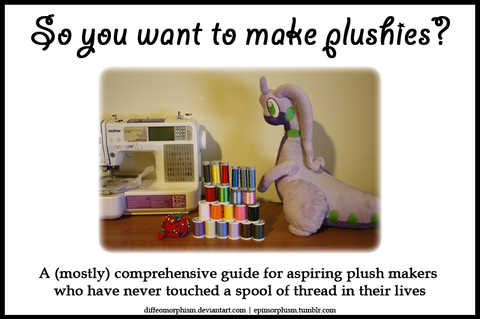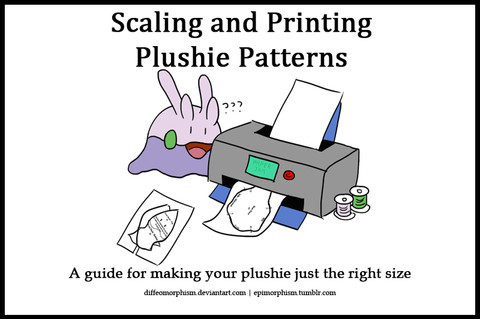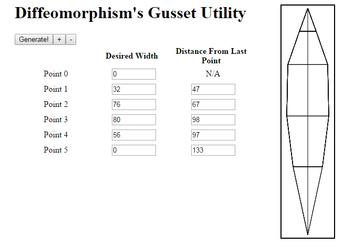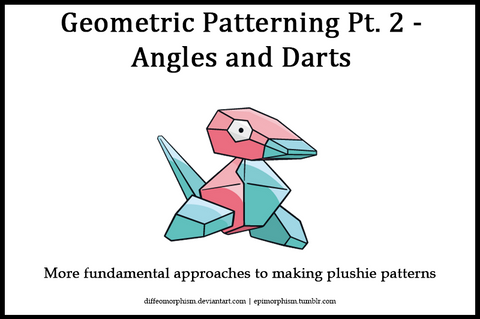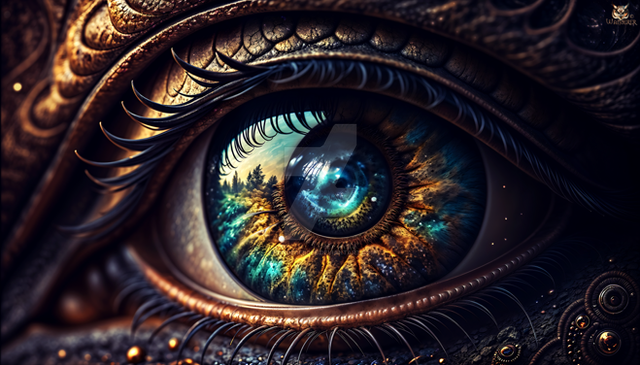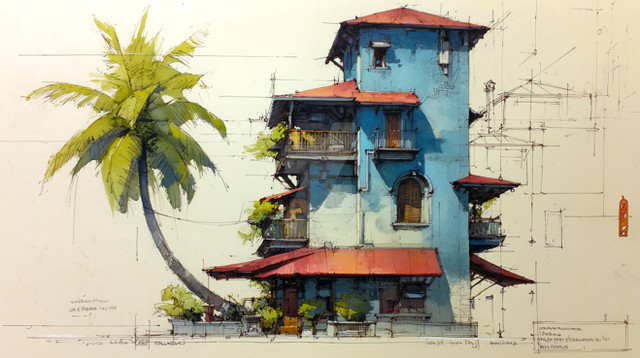HOME | DD
 Diffeomorphism —
A Geometric Approach to Making Plushie Patterns
Diffeomorphism —
A Geometric Approach to Making Plushie Patterns

Published: 2014-03-18 01:55:51 +0000 UTC; Views: 100027; Favourites: 2294; Downloads: 6406
Redirect to original
Description
Here's something that I've been wanting to write up for a while, but never got around to for a couple of months. A lot of people have asked me about the techniques I use when patterning, so in this document lays out in (somewhat excruciating) detail the general approach I take when designing plushies. In general, methodical guides to making patterns are rather lacking on deviantART; I've seen a lot of guides offer only very simplistic advice like "trace out the body shape" without going any further, so this document is an attempt to expand on the varieties of techniques you can use to improve your patterns without having to sculpt foam or anything like that.I understand that this is a very dense and verbose writeup and that it's likely to confuse a decent amount of people, especially since a lot of my examples are rather abstract and a lot of my images are drawn in MS Paint. If someone out there would like to become my personal editor for any future tutorials I write, I'd love to hear from you






 In all seriousness, If there's anything in particular I can attempt to clarify, please leave me a comment! If enough people ask me the same question, I may eventually update the tutorial with new details and clarifications.
In all seriousness, If there's anything in particular I can attempt to clarify, please leave me a comment! If enough people ask me the same question, I may eventually update the tutorial with new details and clarifications.This guide is intended for people who have already put together one or two plushies; if you're a complete beginner looking to get into making plushies, check out my completely non-technical beginner's guide !
Related content
Comments: 125

👍: 0 ⏩: 0

👍: 1 ⏩: 0

👍: 1 ⏩: 0

👍: 0 ⏩: 0

👍: 0 ⏩: 0

Your guides have been indispensable for me. Thank you from the bottom of my heart!
👍: 0 ⏩: 0

Heh, after seeing your presentation at BLFC I wanted to see the things you have posted. This is exactly the kind of thing I've wanted to find about pattern making! There has to be a way to technically look at patterns.
Funny how a lot of people start the same way with the "pillow" form, and gradually move on to gussets and darts. I remember testing different ways to make spheres and experimenting with different shapes.
I used geometry a bit. It's honestly one of my favorite subjects because of how helpful it is in real life application.
I used a mix of stealing patterns from eyeballing plushes I own and adjustments by understanding why each piece shapes the way it does. I've worked carefully to see it in action and have purposefully used different lengths resulting in puckering of the longer length, so I understood it through application and have used it since. Of course the theory side doesn't work for everything, but combining theory and experimentation comes up with much improvement over time!
Some progression (in case you are interested...):
First "pillow" formed plush wasn't photoed. I have a ton of felt pokemon and neopet plushes from childhood.
One of my firsts using basically tubes: orig14.deviantart.net/89dd/f/2…
Newer with some real definition: orig05.deviantart.net/7761/f/2…
Using a figurine to make pattern from 3D: orig04.deviantart.net/ffcf/f/2…
Latest one pattern put together by eyeballing real life plush and using the law of one length (mostly) to fit the parts together:
orig03.deviantart.net/91be/f/2…
orig04.deviantart.net/4a45/f/2…
Sorry for rambling. Thanks to your presentation I have felt more motivated to try making patterns again. It's been over 3 years since my last real project. <:3
I appreciate the amount of time you put into your patterns, it really shows!!
👍: 0 ⏩: 0

I wonder what the official back of a Temmie from Undertale looks like. Otherwise how will plushies be made?!?
👍: 0 ⏩: 0

Heh heh heh, you mentioned in your beginner's tutorial that you were a math major?
Actually, though, thank you! I want to try and make a Swablu, which means lots of hand-patterning, and while I had a basic working pattern for the body, I think I'm going to be able to modify it to make it look more like an ovoid than a sphere. I was also afraid I was going to have to use the pillow approach for feet, beak, etc, but I'm going to try using gussets instead!
👍: 0 ⏩: 0

Wow!! This is amazing! Thank you so much for taking the time to make it
Wish me luck in my first plushie attempt, because I will need it X'D
👍: 0 ⏩: 0

It was interesting, until I see maths...otherwise, interesting post!
👍: 0 ⏩: 0

I too will do the plushie stiching it sounds interesting.
👍: 0 ⏩: 0

This is a very helpful tutorial. Thank you for making it!
👍: 0 ⏩: 0

Solo puedo decir que ame el articulo y que es simplemente impresionante el modo tan técnico de explicar como se crean peluches empleando principios matemáticos, simplemente nunca se me había ocurrido que ambos estuvieran relacionados a pesar del hecho de que las matemáticas son una ciencia que estudia los patrones que hay en todo, desde como funciona un universo hasta como hacer peluches.
👍: 0 ⏩: 1

Muchas gracias por los complidos 
Lo siento, ha sido sobre 4 años que he usado español. Mi habilidad de hablar español probablemente es muy mala...
👍: 0 ⏩: 0

This is fantastic! For years I've thought, "There's got to be a way to use geometry to create these patterns" cuz nothing ever lined up properly. But my geometry is way too weak to figure it out, and here you are, handing over the pattern-making holy grail for free. Thank you so much!
If you've got the time, you should make a book, with plushie tutorials demonstrating this method, and then should sell it on amazon. With some added tutorials, this would be way better than any of the plushie tutorial books I've bought or sampled.
👍: 1 ⏩: 1

You know, the thought of writing a book did once or twice cross my mind as something that would be kind of fun. Honestly though I don't have enough tips to fill up an entire book (though I do have some more tips I'll get around to publishing eventually). Also it would probably be helpful to provide examples for readers, and while now I'm able to use all my Pokemon plushies as references, I probably wouldn't be able to do so if I ever sold it.
👍: 0 ⏩: 1

Well in any case, because of your tutorial thingy, I'm able to make my mom a mother's day gift 
oi61.tinypic.com/29mavpz.jpg
oi59.tinypic.com/6oe6jc.jpg
👍: 0 ⏩: 1

Aww that's cute! I think it's a great gift, I'm glad you were able to use my guide in making it
👍: 0 ⏩: 0

Nice! Geometry really is in everything as my teacher had put it. Thank you!
👍: 0 ⏩: 0

Wow. I mean just...wow. *.* When I went hunting for instructions on how to design and make patterns for plushies, I didn't imagine I'd find something like this! I appreciate your effort and congratulate you on your DD - it's well deserved!
👍: 0 ⏩: 1

No problem, glad I could help!
👍: 0 ⏩: 0

I- Wow! This has got to be the most useful pattern tutorial I've found! The detail you go into is really helpful an leaves nothing unclear or to thought! So thank you for posting this!
👍: 0 ⏩: 1

No problem! Funny though, I thought I left plenty of stuff sorta vague
👍: 0 ⏩: 1

It was rather detailed, which is nice. I love to draw and sew, and I wanted to make a human glados like the one in my gallery~
I really needed the tips
Any tips for human Plushies?
👍: 0 ⏩: 1

I must admit I don't have any tips on humans in particular, I'm more of a fantasy creature plusher myself 
👍: 0 ⏩: 1

Thank you so much for sharing your methods--very helpful indeed even though the math is tough to get through! Especially since I've been out of school for more than 30 years! Lol! I have a question that I've been searching for the answer to and my gut tells me there is a very simple solution that I haven't yet run across. Can you tell me the process of figuring out how to make a shape like a cone but with the tip cut off? I make felt food and often I've needed that sort of shape and have had to resort to finding something of similar size & shape that I can wrap paper around, mark and then flatten. I'm talking about things like a cup, flat bottomed ice cream cone, angel food cake... I understand the shape those things require but not how to get it without basically draping something else. I would very much appreciate your input if you have time.
👍: 0 ⏩: 1

Well, let's see. To make something that's cup-shaped, I would use a similar approach to the cone pattern. You have two circular pieces to deal with: one representing the base of the cone, and a smaller one representing the "cut off" part of the cone. Let's say the circle representing the "cut off" part of the cone has a radius 1/2 of the base circle. Then you would use a similar 4 piece approach for the sides of the cone, except each of the 4 pieces would look trapezoidal instead of triangular, where the top of the trapezoid would be 1/2 of the length of the bottom of the trapezoid. That's how I would go about it. If you need more clarification, let me know, I could hastily sketch out a diagram or something
👍: 0 ⏩: 1

I'll try that--I've been using just one piece that ends up looking similar to a crescent. It works just fine but trying to find something the size I need isn't always possible. I figured there had to be some mathematical way to go about it. Thank you for your time!
👍: 0 ⏩: 0

sweet mama jamma you are a glorious person <3 thank you so much for putting this up and taking time to make it
👍: 0 ⏩: 0

I'm not even all the way through reading it yet and I just want to say how frickin' amazing this is. You're explaining this in ways I had never ever thought of before, all I had ever heard about pattern making was "just guess until you get it right!" even from the utmost of professionals.
I've made a few plushies and other things from other people's patterns, but I really want to create my own. The problem is I have such trouble thinking in 3D, but somehow just knowing that there's some kind of mathematical approach to it that is, in fact, usable makes me feel like it's maybe not as intimidating as I was afraid of! Thank you!
👍: 0 ⏩: 1

Did people really only tell you "guess until you get it right"? I mean, sure, guesswork definitely comes into play at times, but I must say that's probably the least constructive "advice" I've ever heard
Thinking in 3D is definitely a challenge! I took a class on multivariable calculus a few years ago, and I had to quickly wrap my head around how things unfold in 3D. In fact, a lot of my intuition is probably grounded in what I learned in calculus! But it's not like you need calculus to make plushies, you just gotta have the right approach to get you started, and this is pretty much the approach that I use.
👍: 0 ⏩: 1

You have no idea. I always felt there had to be some "trick" to it, some starting point, but all I ever could find was just to experiment until the pieces fit together the way you want them to. Well that's all well and good, but what if you have absolutely no idea where to begin? One person had a somewhat more helpful suggestion of building the thing in 3D and draping fabric over that to figure it out and picture it better, but I just knew there had to be a better way. I had no idea about anything as simple as how to make the curved line length match the straight line length! This is going to make everything so much easier!
I have so much respect for people good at math, I am so impressed. 

I actually just finished reading this and it was even more stupendous and useful than I thought when I left my first comment! 
👍: 0 ⏩: 0

Love the guide!! Thank you!
(also, LateX typesetting!!?? )
👍: 0 ⏩: 1

I've never actually used any of the image libraries for LaTeX, but ultimately for deploying text-heavy documents with things like images and clickable ToCs with only a few intermittent formulas, I find that using Microsoft Word is more time efficient than LaTeX. I use LaTeX for stuff like math homework when putting a million equations on the document makes Word start to lag (or when I need access to fancy mathematical notation Word doesn't have).
👍: 0 ⏩: 1

Thanks! I always wondered if there is a better way to include images into documents. Besides enjoying your plush instructions, I also noticed how neatly the images fit in your documents. Lately I've been doing some typesetting with LateX to organize the sections, day-to-day class notes, etc, but not sure if it's more efficient to do it with LateX or if it would've been fine over Word doc. Anyhow, thanks for your guides! I've just started making plushes and ive decided to invest in a pin cushion and other basic stuff according to your beginners guide
👍: 0 ⏩: 1

Depends what you're taking notes on. For ordinary classes LaTeX might be a little overkill 
👍: 0 ⏩: 0

This is so great! Thank you very much for this great tutorial!
👍: 0 ⏩: 0

This is so amazing! I love this composition and style! Really good work! Congratulations!
👍: 0 ⏩: 0

Wow, making plushies is serious business...
👍: 0 ⏩: 0
| Next =>
